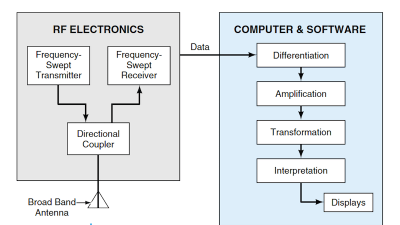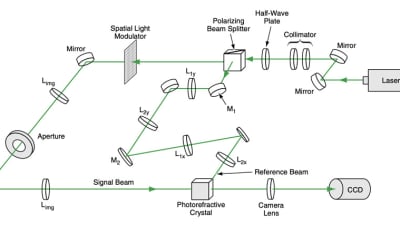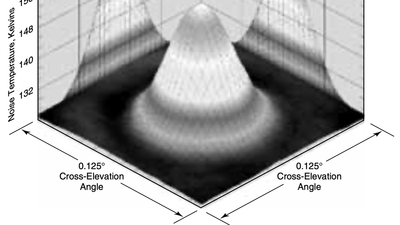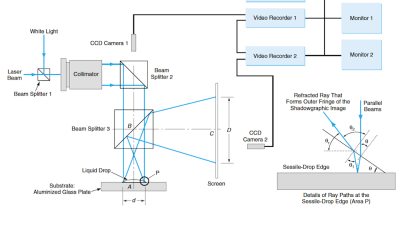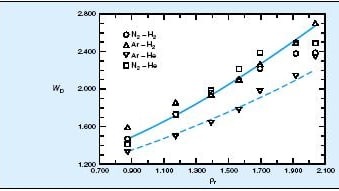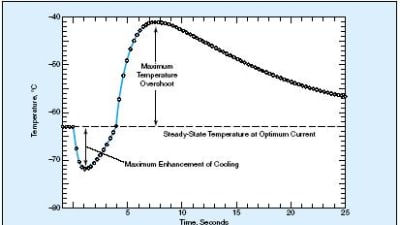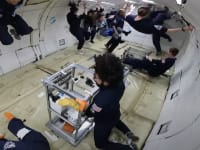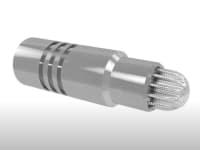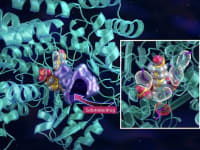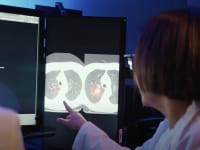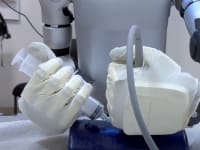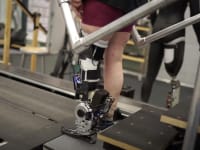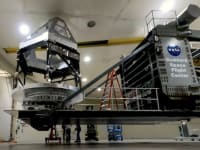Stories
6
61
-1
1260
30
Briefs: Photonics/Optics
Optoelectronic sensors and magnetic actuators have been developed as parts of a system for controlling the relative position and attitude of two massive optical tables that float on...
Briefs: Physical Sciences
Part 2 of a Computational Study of a Drop-Laden Mixing Layer
This second of three reports on a computational study of a mixing layer laden with evaporating liquid drops presents the evaluation of Large Eddy Simulation (LES) models.
Briefs: Physical Sciences
A proposed technique for locating concealed objects (especially small antipersonnel land mines) involves the acquisition and processing of spectral signatures over broad microwave...
Briefs: Photonics/Optics
A holographic technique has been devised for generating a visible display of the effect of exposure of a photorefractive crystal to γ-rays. The technique exploits the space charge that results from...
Briefs: Photonics/Optics
A digital averaging phasemeter has been built for measuring the difference between the phases of the unknown and reference heterodyne signals in a heterodyne laser interferometer. This...
Briefs: Software
Preparing and Analyzing Iced Airfoils
SmaggIce version 1.2 is a computer program for preparing and analyzing iced airfoils.It includes interactive tools for
measuring ice-shape characteristics,
controlled smoothing of ice shapes,
curve discretization,
generation of artificial ice shapes,and
detection and correction of input errors.
Briefs: Physical Sciences
Working Fluids for Increasing Capacities of Heat Pipes
A theoretical and experimental investigation has shown that the capacities of heat pipes can be increased through suitable reformulation of their working fluids. The surface tensions of all of the working fluids heretofore used in heat pipes decrease with temperature. As explained in more...
Briefs: Physical Sciences
An improved method of calibrating a large directional radio antenna of the type used in deep-space communication and radio astronomy has been developed. This method involves a...
Briefs: Physical Sciences
A modified coronagraph has been proposed as a prototype of improved notch filters in Raman spectrometers. Corona-graphic notch filters could offer alternatives to both (1) the large and...
Briefs: Physical Sciences
Rapid Chemometric Filtering of Spectral Data
A method of rapid, programmable filtering of spectral transmittance, reflectance, or fluorescence data to measure the concentrations of chemical species has been proposed. By "programmable" is meant that a variety of spectral analyses can readily be performed and modified in software, firmware,...
Briefs: Physical Sciences
Part 1 of a Computational Study of a Drop-Laden Mixing Layer
This first of three reports on a computational study of a drop-laden temporal mixing layer presents the results of direct numerical simulations (DNS) of well-resolved flow fields and the derivation of the large-eddy simulation (LES) equations that would govern the larger scales of a...
Briefs: Physical Sciences
Selected Papers on Protoplanetary Disks
Three papers present studies of thermal balances, dynamics, and electromagnetic spectra of protoplanetary disks, which comprise gas and dust orbiting young stars. One paper addresses the reprocessing, in a disk, of photons that originate in the disk itself in addition to photons that originate in the stellar...
Briefs: Physical Sciences
Integrated-Optic Oxygen Sensors
Compact optical oxygen sensors with self-calibration capabilities are undergoing development. A sensor of this type features a single-chip, integrated-optic design implemented by photolithographic fabrication of optical waveguides in a photosensitive porous glass. The porosity serves as both a matrix for retention of...
Briefs: Physical Sciences
Hybrid Piezoelectric/Fiber-Optic Sensor Sheets
Hybrid piezoelectric/fiber-optic (HyPFO) sensor sheets are undergoing development. They are intended for use in nondestructive evaluation and long-term monitoring of the integrity of diverse structures, including aerospace, aeronautical, automotive, and large stationary ones. It is anticipated that the...
Briefs: Physical Sciences
A module that dissolves oxygen in water at concentrations approaching saturation, without generating bubbles of oxygen gas, has been developed as a prototype of improved oxygenators for...
Briefs: Physical Sciences
Arrays of multiple, nominally identical sensors with sensor-output-processing electronic hardware and software are being developed in order to obtain accuracy, reliability, and lifetime...
Briefs: Physical Sciences
A laser cooling apparatus that generates a cold beam of rubidium and cesium atoms at low pressure has been constructed as one of several intermediate products of a continuing program...
Briefs: Physical Sciences
Multispectral Scanner for Monitoring Plants
A multispectral scanner has been adapted to capture spectral images of living plants under various types of illumination for purposes of monitoring the health of, or monitoring the transfer of genes into, the plants. In a health-monitoring application, the plants are illuminated with full-spectrum visible...
Briefs: Physical Sciences
Brush/Fin Thermal Interfaces
Brush/fin thermal interfaces are being developed to increase heat-transfer efficiency and thereby enhance the thermal management of orbital replaceable units (ORUs) of electronic and other equipment aboard the International Space Station. Brush/fin thermal interfaces could also be used to increase heat-transfer...
Briefs: Physical Sciences
Compensating for Effects of Humidity on Electronic Noses
A method of compensating for the effects of humidity on the readouts of electronic noses has been devised and tested. The method is especially appropriate for use in environments in which humidity is not or cannot be controlled — for example, in the vicinity of a chemical spill, which can...
Briefs: Physical Sciences
White-Light Nulling Interferometers for Detecting Planets
A report proposes the development of a white-light nulling interferometer to be used in conjunction with a single-aperture astronomical telescope that would be operated in outer space. When such a telescope is aimed at a given star, the interferometer would suppress the light of that star...
Briefs: Physical Sciences
As an alternative to conventional tubing instrumentation for measuring airflow, designers and technicians at Glenn Research Center have been fabricating packaging components and assembling a set of unique...
Briefs: Physical Sciences
The figure depicts an apparatus that simultaneously records magnified ordinary top-view video images and laser shadowgraph video images of a sessile drop on a flat, horizontal...
Briefs: Physical Sciences
A methodology for improving gravity-gradient measurement data exploits the constraints imposed upon the components of the gravity-gradient tensor by the conditions of integrability...
Briefs: Physical Sciences
Time-Transfer System for Two Orbiting Spacecraft
A report describes the time-transfer system of the Gravity Recovery and Climate Experiment (GRACE), in which information on the distribution of Earth mass is extracted from position and time measurements for two spacecraft about 200 km apart in a circular, nearly polar orbit. Each spacecraft carriers...
Briefs: Physical Sciences
A comprehensive mathematical model of mass diffusion has been developed for binary fluids at high pressures, including critical and supercritical pressures. Heretofore, diverse...
Briefs: Physical Sciences
The rates of cooling afforded by thermoelectric (Peltier) devices can be increased for short times by applying pulses of electric current greater than the currents that yield maximum...
Briefs: Physical Sciences
An improved cryostat has been developed for cooling a wide panel evenly over its surface to a temperature of -423 °F (≈-253 °C) by use of liquid helium. Originally, the cryostat was to be used in...
Briefs: Physical Sciences
Waste-Heat-Driven Cooling Using Complex Compound Sorbents
Improved complex-compound sorption pumps are undergoing development for use as prime movers in heat-pump systems for cooling and dehumidification of habitats for humans on the Moon and for residential and commercial cooling on Earth. Among the advantages of sorption heat-pump systems are...
Top Stories
Blog: Manufacturing & Prototyping
2025 Holiday Gift Guide for Engineers: Tech, Tools, and Gadgets
INSIDER: Research Lab
Scientists Create Superconducting Semiconductor Material
Blog: Software
Quiz: Materials
Blog: Aerospace
Tech Briefs Wrapped 2025: Top 10 Technology Stories
Blog: Manufacturing & Prototyping
Webcasts
 Upcoming Webinars: AR/AI
Upcoming Webinars: AR/AI
The Real Impact of AR and AI in the Industrial Equipment Industry
 Upcoming Webinars: Motion Control
Upcoming Webinars: Motion Control
Next-Generation Linear and Rotary Stages: When Ultra Precision...
 Upcoming Webinars: Energy
Upcoming Webinars: Energy
Hydrogen Engines Are Heating Up for Heavy Duty
 Podcasts: Medical
Podcasts: Medical
How Wearables Are Enhancing Smart Drug Delivery
 Podcasts: Power
Podcasts: Power
SAE Automotive Podcast: Solid-State Batteries



